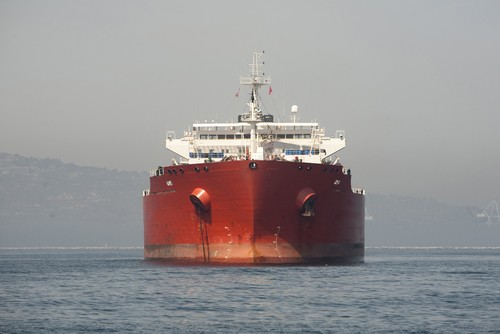(Bloomberg) — The glut of oil tankers competing to load in the Persian Gulf dwindled to a seven-month low as China draws shipments, setting the conditions for rates to extend the year’s biggest rally.
Fifty-five very large crude carriers are available in the world’s biggest exporting region in the next four weeks, the fewest since March 27, according to Marex Spectron Group, which handles freight derivatives. There have been 141 tankers booked to load this month, the most since December, said Kevin Sy, a broker at Marex Spectron in Singapore.
Increased imports into China are drawing the vessels away from their busiest loading region, enabling owners to negotiate higher rates, according to Arctic Securities ASA, an Oslo-based investment bank. Daily earnings for the ships will rise to $40,000, from $24,000 now, according to DNB Markets.
“Fixtures have been high over the past week,” Erik Nikolai Stavseth, an analyst at Arctic, said in an e-mailed report today. “We could see a slower pace next week. However, the low vessel count should balance this, giving owners impetus to ask for a higher rate.”
China, the world’s largest energy consumer, imported 23.68 million metric tons of crude last month, the most since May, customs data show. A VLCC holds about 2 million barrels. About 13 percent of the global fleet is heading for China, ship- tracking data compiled by Bloomberg show.
Rates Jumped
Rates jumped 38 percent since the start of the month to the highest since May 30, according to the Baltic Exchange, the London-based publisher of shipping costs. Charter costs for VLCCs on the voyage added 0.1 percent to 49.84 industry-standard Worldscale points, exchange data showed today. The VLCC fleet will expand 6.8 percent this year, exceeding 4.8 percent demand growth, estimates Clarkson Research Services Ltd., a unit of the world’s largest shipbroker.
The Worldscale system is a method for pricing oil cargoes on thousands of trade routes. Each individual voyage’s flat rate, expressed in dollars a ton, is set once a year. Today’s level means hire costs on the benchmark route are 49.84 percent of the nominal Worldscale rate for that voyage.
Daily earnings for very large crude carriers on the Saudi Arabia-to-Japan voyage slipped 2.8 percent to $19,456, figures from the exchange showed. That snapped a series of nine straight gains, the longest winning streak since a run that ended March 16, exchange data showed.
Faster Ships
The rally can last as much as three more weeks before ships accelerate, effectively adding capacity, DNB analysts led by Nicolay Dyvik in Oslo said in an e-mailed report today. Sailing slower has lifted the fleet’s utilization to 87 percent, compared with 73 percent at normal speeds, estimates the investment-banking unit of Norway’s largest bank.
“A sudden pick-up in demand or supply shock or disruptions will tighten the market balance short term from an already tight level, before vessel speed will increase and redress the supply side,” Dyvik said in the report. “The current pick-up in activity relates to a flurry of fixing” from the Persian Gulf to Asia, he added.
The Baltic Dirty Tanker Index, a broader measure of oil- shipping costs that includes vessels smaller than VLCCs, was unchanged at 715 points, according to the exchange today.
-By Isaac Arnsdorf. Copyright 2012 Bloomberg.
Unlock Exclusive Insights Today!
Join the gCaptain Club for curated content, insider opinions, and vibrant community discussions.

 Join The Club
Join The Club













